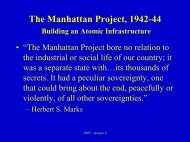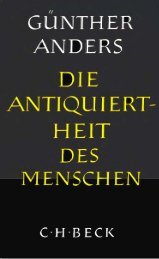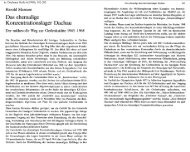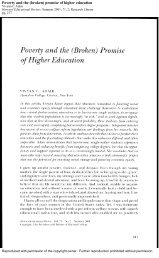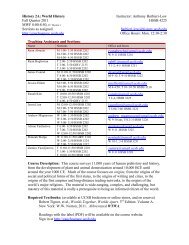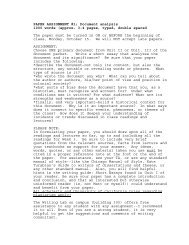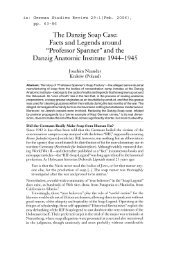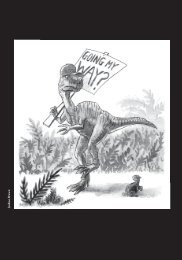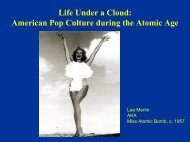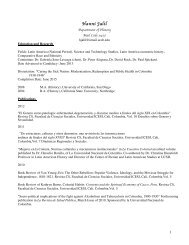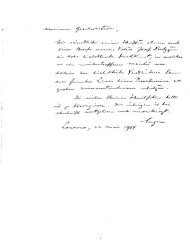Manhattan Project - Prologue - UCSB Department of History
Manhattan Project - Prologue - UCSB Department of History
Manhattan Project - Prologue - UCSB Department of History
You also want an ePaper? Increase the reach of your titles
YUMPU automatically turns print PDFs into web optimized ePapers that Google loves.
<strong>Manhattan</strong> <strong>Project</strong> - <strong>Prologue</strong><br />
• The race for the Bomb…all the elements <strong>of</strong><br />
high drama: earth-shaking discoveries,<br />
matters <strong>of</strong> life and death, decisions that<br />
would affect the lives <strong>of</strong> millions and the<br />
future <strong>of</strong> humanity all played out on a<br />
global stage.<br />
2005 - lecture 5
• Remember the bigger picture: Virtually all<br />
ideas associated with nuclear weapons that<br />
shaped the Cold War derive from the<br />
attitudes and assumptions formulated 1941-<br />
45:<br />
• Nuclear bargaining chips<br />
• Bomb as a diplomatic tool<br />
• Need for secrecy and speed<br />
• Science-state-public-industry relations<br />
2005 - lecture 5
<strong>Manhattan</strong> <strong>Project</strong><br />
• The scale <strong>of</strong> <strong>Manhattan</strong> <strong>Project</strong><br />
– $2 billion cost ($225 billion today)<br />
– Over 120,000 people employed to build the<br />
atomic bombs<br />
– Work done at over three dozen sites in 19 states<br />
2005 - lecture 5
<strong>Manhattan</strong> <strong>Project</strong> Scientists:<br />
Soldiers out <strong>of</strong> Uniform<br />
• Their participation in <strong>Manhattan</strong> <strong>Project</strong> –<br />
The single most pr<strong>of</strong>ound experience in the<br />
history <strong>of</strong> the American scientific<br />
community.<br />
– Intellectual, financial, political, pr<strong>of</strong>essional,<br />
and moral implications<br />
– Linked basic research with military applications<br />
2005 - lecture 5
Scientific Understanding Continues to Grow<br />
• Bohr’s sudden realization about U-235<br />
(Feb. 1939)<br />
– Publishes paper in Sept. 1939 with Princeton’s<br />
John Wheeler that shows only U-235 will<br />
fission easily. One <strong>of</strong> last openly published<br />
papers on fission research<br />
• Scientists “looking for neutrons” in Paris<br />
and New York (winter 1939)<br />
2005 - lecture 5
• French research; publication in April 1939<br />
gives pro<strong>of</strong> that enough neutrons are<br />
produced to sustain a chain reaction.<br />
• British and German governments begin to<br />
take increasing interest (unlike in the U.S.)<br />
2005 - lecture 5
• Szilard wires Lewis Strauss: “ESTIMATE<br />
CHANCES FOR REACTION NOW<br />
ABOVE 50”<br />
• Szilard: “That night, there was very little<br />
doubt in my mind that the world was<br />
headed for grief.”<br />
2005 - lecture 5
Uranium Overview<br />
• There are two main forms <strong>of</strong> uranium<br />
–U-238<br />
• Much more common; can both capture neutrons and<br />
be fissioned by them<br />
–U-235<br />
• Represents only 0.7% <strong>of</strong> uranium<br />
• Weighs slightly less than U-238<br />
• Fissions much more easily than U-238; doesn’t<br />
capture neutrons.<br />
• Much more unstable.<br />
2005 - lecture 5
• To make a nuclear reactor, U-238 will work<br />
fine.<br />
• But, to make a bomb, you need pure U-235.<br />
2005 - lecture 5
• The problem is how to separate the U-235<br />
from the U-238.<br />
– This process is called “enrichment”<br />
• Scientists still skeptical about how to get<br />
enough U-235 (several hundred pounds are<br />
thought necessary as <strong>of</strong> 1939):<br />
– As Niels Bohr said: “It can never be done<br />
unless you turn the United States into one huge<br />
factory.”<br />
2005 - lecture 5
Einstein’s Letter to FDR<br />
• Leo Szilard is worried; meets summer <strong>of</strong> 1939<br />
with:<br />
• Edward Teller (Hungarian, refugee, and later “father” <strong>of</strong><br />
the U.S. hydrogen bomb)<br />
• Eugene Wigner (Hungarian, 1902-1995; Nobel 1963)<br />
• The three scientists visit Einstein on Long Island<br />
and draft letter to Franklin D. Roosevelt<br />
– Einstein signs it.<br />
• Irony:<br />
• Einstein himself played no role in the <strong>Manhattan</strong> <strong>Project</strong><br />
and was denied security clearance as a German supporter<br />
<strong>of</strong> left-wing causes.<br />
2005 - lecture 5
Reconstruction <strong>of</strong> the letter<br />
signing<br />
2005 - lecture 5
Analyzing The Letter<br />
• Historical significance<br />
• Contains key themes that would define the<br />
<strong>Manhattan</strong> <strong>Project</strong> (and the Cold War arms<br />
race).<br />
2005 - lecture 5
“Einstein’s” Letter<br />
• What does it say?<br />
• “it may be possible to set up a nuclear chain<br />
reaction in a large mass <strong>of</strong> uranium, by<br />
which vast amounts <strong>of</strong> power and large<br />
quantities <strong>of</strong> new radium-like elements<br />
would be generated.”<br />
• “…you may think it desirable to have some<br />
permanent contact maintained between the<br />
Administration and the group <strong>of</strong> physicists<br />
working on chain reactions in America.”<br />
2005 - lecture 5
• “a) to approach Government <strong>Department</strong>s, keep<br />
them informed <strong>of</strong> the further development, and put<br />
forward recommendations for Government action,<br />
giving particular attention to the problem <strong>of</strong><br />
securing a supply <strong>of</strong> uranium ore for the United<br />
States. b) to speed up the experimental work, which<br />
is at present being carried on within the limits <strong>of</strong> the<br />
budgets <strong>of</strong> University laboratories, by providing<br />
funds…”<br />
• “I understand that Germany has actually stopped the<br />
sale <strong>of</strong> uranium from the Czechoslovakian mines<br />
which she has taken over.”<br />
2005 - lecture 5
Initial U.S. Interest in Atomic Power<br />
• Enrico Fermi goes to Washington, DC<br />
(March 1939)<br />
• Military’s interest is not a bomb but nuclear<br />
power…little support given.<br />
2005 - lecture 5
• Later in 1939 – after Einstein’s letter – FDR<br />
creates the Uranium Advisory Committee<br />
(<strong>of</strong>f-shoot <strong>of</strong> the National Bureau <strong>of</strong><br />
Standards)<br />
• October 1939: Wigner, Szilard, Teller meet<br />
with the military.<br />
– Result? Finally, money continue fission<br />
research and commit the U.S. government to it.<br />
How much?<br />
• $6,000 !!?<br />
2005 - lecture 5
Meanwhile, in England…<br />
• Otto Frisch and Rudolf Peierls are studying<br />
the idea <strong>of</strong> critical mass<br />
• The minimum mass <strong>of</strong> a fissionable material that<br />
will just maintain a fission chain reaction under<br />
precisely specified conditions.<br />
• Instead <strong>of</strong> several tons, they calculate a few pounds<br />
<strong>of</strong> U235 is needed.<br />
• Spring <strong>of</strong> 1940: Frisch and Peierls write a<br />
memo to English government…<br />
2005 - lecture 5
Scientific Understanding Continues to Grow, II<br />
• Later (summer 1940) scientists<br />
at UC-Berkeley discover that<br />
uranium can be bombarded<br />
with neutrons to make<br />
plutonium (a new element).<br />
• Glenn Seaborg (American<br />
chemist, 1912-1999; shared<br />
Nobel in chemistry in 1951).<br />
2005 - lecture 5
The Possibility <strong>of</strong> Plutonium<br />
• What happens to U-238 when it captures a<br />
neutron?<br />
– U-238 + neutron -> U-239 -> Np-239 -> Pu-239<br />
2005 - lecture 5
• Scientists predict that Pu-239 has the same<br />
fission characteristics as U-235 and can be<br />
used in a bomb.<br />
• Also, scientists expect Pu-239 can be<br />
produced in a uranium-fueled nuclear<br />
reactor.<br />
– The problem is how to separate the plutonium<br />
from the uranium. This can be done chemically<br />
– easier yet expensive and messy.<br />
2005 - lecture 5
British Investigations<br />
• After Frisch/Peierls memo, British form a<br />
small group <strong>of</strong> scientists in 1940– MAUD<br />
committee (Thomson, Chadwick,<br />
Cockcr<strong>of</strong>t…)<br />
• “We entered the project with more<br />
skepticism than belief…” they said later.<br />
• After further investigation, the skepticism<br />
vanished.<br />
2005 - lecture 5
• Committee devotes attention to how to<br />
separate U-235<br />
– One possibility: gaseous diffusion<br />
separation…what’s this?<br />
2005 - lecture 5
• By spring <strong>of</strong> 1941, Chadwick recalled:<br />
– “I realized that a nuclear bomb was not only<br />
possible – it was inevitable…And I had then to<br />
start taking sleeping pills.”<br />
2005 - lecture 5
The MAUD Report - July 1941<br />
• What does it say?<br />
– Bomb is possible<br />
– Pursue w/o delay<br />
– Cost to make U-235 to be £5,000,000<br />
– Possible to have ready by 1943<br />
– Germans are working on this too.<br />
• Report outlines the basic idea <strong>of</strong> how a<br />
bomb would work with about 22 pounds <strong>of</strong><br />
U-235<br />
2005 - lecture 5
• Conclusions/Recommendations:<br />
– Bomb possible<br />
– Work needed on increased scale at highest<br />
priority<br />
– Cooperate with the US.<br />
• **MAUD report and Frisch/Peierls memo is<br />
what spurs U.S. to action.<br />
2005 - lecture 5
Meanwhile in Nazi Germany…<br />
• German bomb research proceeding<br />
– Unaware <strong>of</strong> potential possibilities <strong>of</strong> plutonium<br />
– Using heavy water (instead <strong>of</strong> graphite as in US) as a<br />
moderator<br />
• Moderator – slows down neutrons so fission can take place.<br />
Graphite better and cheaper than heavy water.<br />
• September 1941 – Werner Heisenberg’s infamous<br />
meeting in Copenhagen with Niels Bohr.<br />
2005 - lecture 5
Back in the U.S…<br />
• Vannevar Bush and the National Defense Research<br />
Council (NRDC) take over US uranium work. James<br />
Conant (chemist and pres. <strong>of</strong> Harvard put in charge)<br />
Arthur Compton<br />
Bush<br />
Karl Compton<br />
Lawrence<br />
Conant<br />
A. Loomis<br />
2005 - lecture 5
• Money begins to flow<br />
– July 1940 - $40,000 more put into work<br />
• Efforts directed not for bomb but for Enrico<br />
Fermi’s studies <strong>of</strong> uranium reactor.<br />
2005 - lecture 5
• By fall <strong>of</strong> 1941, Compton, Conant,<br />
Lawrence, Bush – encouraged by MAUD<br />
report – urge FDR to undertake large bomb<br />
project.<br />
• FDR separates scientists from policy<br />
decisions.<br />
• FDR (informally) authorizes $1.2 million<br />
and urges crash program.<br />
• December 6, 1941: FDR authorizes the<br />
<strong>Manhattan</strong> Engineering District.<br />
2005 - lecture 5
And then…<br />
2005 - lecture 5



